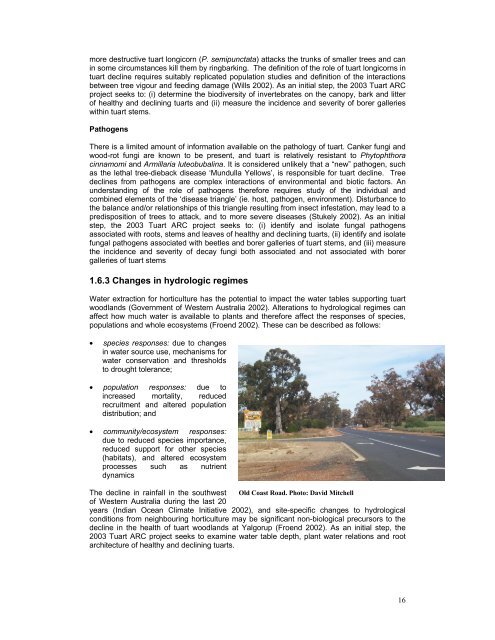DRAFT Tuart Conservation and Management Strategy
DRAFT Tuart Conservation and Management Strategy
DRAFT Tuart Conservation and Management Strategy
You also want an ePaper? Increase the reach of your titles
YUMPU automatically turns print PDFs into web optimized ePapers that Google loves.
more destructive tuart longicorn (P. semipunctata) attacks the trunks of smaller trees <strong>and</strong> can<br />
in some circumstances kill them by ringbarking. The definition of the role of tuart longicorns in<br />
tuart decline requires suitably replicated population studies <strong>and</strong> definition of the interactions<br />
between tree vigour <strong>and</strong> feeding damage (Wills 2002). As an initial step, the 2003 <strong>Tuart</strong> ARC<br />
project seeks to: (i) determine the biodiversity of invertebrates on the canopy, bark <strong>and</strong> litter<br />
of healthy <strong>and</strong> declining tuarts <strong>and</strong> (ii) measure the incidence <strong>and</strong> severity of borer galleries<br />
within tuart stems.<br />
Pathogens<br />
There is a limited amount of information available on the pathology of tuart. Canker fungi <strong>and</strong><br />
wood-rot fungi are known to be present, <strong>and</strong> tuart is relatively resistant to Phytophthora<br />
cinnamomi <strong>and</strong> Armillaria luteobubalina. It is considered unlikely that a “new” pathogen, such<br />
as the lethal tree-dieback disease ‘Mundulla Yellows’, is responsible for tuart decline. Tree<br />
declines from pathogens are complex interactions of environmental <strong>and</strong> biotic factors. An<br />
underst<strong>and</strong>ing of the role of pathogens therefore requires study of the individual <strong>and</strong><br />
combined elements of the ‘disease triangle’ (ie. host, pathogen, environment). Disturbance to<br />
the balance <strong>and</strong>/or relationships of this triangle resulting from insect infestation, may lead to a<br />
predisposition of trees to attack, <strong>and</strong> to more severe diseases (Stukely 2002). As an initial<br />
step, the 2003 <strong>Tuart</strong> ARC project seeks to: (i) identify <strong>and</strong> isolate fungal pathogens<br />
associated with roots, stems <strong>and</strong> leaves of healthy <strong>and</strong> declining tuarts, (ii) identify <strong>and</strong> isolate<br />
fungal pathogens associated with beetles <strong>and</strong> borer galleries of tuart stems, <strong>and</strong> (iii) measure<br />
the incidence <strong>and</strong> severity of decay fungi both associated <strong>and</strong> not associated with borer<br />
galleries of tuart stems<br />
1.6.3 Changes in hydrologic regimes<br />
Water extraction for horticulture has the potential to impact the water tables supporting tuart<br />
woodl<strong>and</strong>s (Government of Western Australia 2002). Alterations to hydrological regimes can<br />
affect how much water is available to plants <strong>and</strong> therefore affect the responses of species,<br />
populations <strong>and</strong> whole ecosystems (Froend 2002). These can be described as follows:<br />
• species responses: due to changes<br />
in water source use, mechanisms for<br />
water conservation <strong>and</strong> thresholds<br />
to drought tolerance;<br />
• population responses: due to<br />
increased mortality, reduced<br />
recruitment <strong>and</strong> altered population<br />
distribution; <strong>and</strong><br />
• community/ecosystem responses:<br />
due to reduced species importance,<br />
reduced support for other species<br />
(habitats), <strong>and</strong> altered ecosystem<br />
processes such as nutrient<br />
dynamics<br />
The decline in rainfall in the southwest Old Coast Road. Photo: David Mitchell<br />
of Western Australia during the last 20<br />
years (Indian Ocean Climate Initiative 2002), <strong>and</strong> site-specific changes to hydrological<br />
conditions from neighbouring horticulture may be significant non-biological precursors to the<br />
decline in the health of tuart woodl<strong>and</strong>s at Yalgorup (Froend 2002). As an initial step, the<br />
2003 <strong>Tuart</strong> ARC project seeks to examine water table depth, plant water relations <strong>and</strong> root<br />
architecture of healthy <strong>and</strong> declining tuarts.<br />
16

















